Author: Marshall Schott
For some, brewing is all about stripping the process down without worrying about the finer details. A handful of this, a sprinkle of that, voila, beer! As much as I appreciate this mentality, I definitely cannot relate, as I’m a nut for precision when it comes to making beer and I get my kicks off of knowing I hit certain target numbers. As any brewer is very well aware, there are a lot these target numbers in brewing, all of which rely on specific instruments for measurement. One of the measurements focused on most in brewing has to do with the amount of sugar present in solution, as it provides information to the brewer about mash efficiency and ultimately allows us to determine the strength of a beer. There are a few different scales used by brewers to measure this sugar content, which can understandably cause a bit of confusion, hence this very brief attempt at an explanation.
The most popular scale used by homebrewers is specific gravity (SG), which is the ratio of the density of a substance (wort/beer) to the density of a reference substance (water). The tool used to make such measurements is the hydrometer, a science-y looking device included in most homebrew starter kits. More commonly used by professional brewers, the degrees Plato (°P) scale represents the sugar content of a solution as percentage by mass, which is basically the same as the degrees Brix (°Bx) scale often used by winemakers. While Plato and Brix are ever so slightly different, it’s so small that many accept them as being largely interchangeable. The tool generally used to measure °P and °Bx is the refractomer, a device that relies on the index of refraction to determine the sugar content of a solution.
I’ve gone through my fair share of hydrometers over the years, as they don’t seem to hold up too well to being dropped on concrete garage floors. Desiring a less breakable option that was more precise and didn’t require such a large volume of wort for measurement, I picked up my first handheld refractometer a few years ago. What I appreciate most about these types of refractometers is how quick they provide readings and how small of a wort/beer sample they require. However, it’s been my experience that the blue coloring in the daylight plate fades with time, making it difficult if not impossible to get an accurate reading. I’ve had to toss 2 refractometers so far because of this. Also, as much as it may not really matter, the closeness of the hash marks hinders the ability to get truly precise measurements. For that, one would require a device with a bit more oomph.
A representative from Hanna Instruments recently reached out to chat about various products they manufacture for use in brewing, one of which is a digital refractometer. Given the nature of what we do here at Brülosophy, this device seemed liked a legit way to ensure the most accurate readings possible, so when asked to put one through its paces and provide an honest review, I accepted!
The product reviewed for this article was provided by the manufacturer in exchange for an honest review; no other compensation was provided. The opinions expressed in the article are solely those of the author and a concerted effort was made to approach the review from an unbiased perspective.
Since this isn’t a technical paper covering exactly how refractometers work, I’ll focus my review on the stuff that matters to most brewers. Real quick, there’s a really simple method for converting SG to °P and vice versa that’s surprisingly accurate:
°P = last 2 digits of SG/4
SG = °P x 4
So a reading of, say, 12 °P on the digital refractometer would equate about 1.048 SG. I prefer to use a calculator for accuracy’s sake, personally, but as a rudimentary method, this works pretty well.
Build Quality
The unit arrived in a well packed box containing the digital refractometer, batteries, a pipette, a small piece of microfiber cloth, and an instruction pamphlet.
Immediately upon removing the refractometer from the box, it was apparent by the weight and feel how durable it was. The water resistant ABS plastic housing feels sturdy enough to withstand the bumps bound to happen in any brewery while the sample well is made of stainless steel, which is both strong and very easy to clean.
The functions on the refractometer are simple and generally self-explanatory, just 3 buttons for powering it on/off, calibration, and taking the reading.
Calibration
After spending all of 30 seconds installing the battery, I read through the fairly brief instruction pamphlet and noticed they recommend calibrating the unit with distilled water prior to every use. Out of curiosity, I decided to take a reading of the water without calibrating first and found the refractometer was already spot on.
I then went through the very simple calibration process just because the instructions said I should before moving into a comparison of different devices.
Accuracy
Since I wasn’t brewing when the refractometer arrived, I did an initial accuracy test using store-bought apple juice, which I’ve learned through cider making is usually between 1.048 – 1.054 SG, or 12.4 – 13.3 °P. After ensuring my hydrometer and handheld refractometer were calibrated, I measured the juice with each.
Interestingly, while my calibrated handheld refractometer showed the exact same ˚P as the digital refractometer, the SG was 0.003 points shy of the calculated conversion to 1.053 SG. Because I’ve only ever paid attention to the SG reading from my handheld refractometer, I’m only now realizing my slightly lower than expected brewhouse efficiency may not actually be lower. Huh.
Automatic Temperature Compensation (ATC)
A lot of handheld refractometers are advertised as having ATC, or automatic temperature compensation, which really just amounts to the daylight plate cooling the sample somewhat quickly given it’s just a couple drops. Nothing about it is really “automatic” and I’ve found waiting about 45 seconds after adding the sample to the plate results in more accurate readings. While the Hanna digital refractometer actually compensates for the temperature of the liquid in the well, I found this not to be much of an issue since the few drops of liquid used usually stabilize at ambient temperature within a few seconds anyway. I attempted to test this out on brew day by measuring 3 samples of the same wort at different temperatures, but it proved difficult, likely due to the starting temperature of the stainless sample well. Regardless, in each case, immediate readings of the 3 samples were identical and all 3 stabilized at the same ambient temperature within 30 seconds. It should also be noted the temperature can be displayed in either Celsius or Fahrenheit.
Speed
Hanna claims the digital refractometer takes approximately 1.5 seconds to display readings, a claim I thought best to test out.
I initially intended to record my phone’s timer next to the refractometer, but that proved difficult because I was using my phone to record… yeah. Anyway, readings are displayed basically immediately.
Ease of Use
Using the Hanna digital refractometer is easy. Very, very easy. Just turn the unit on, drop a sample in the well, then press the “read” button. Since refraction is a function of light, brighter environments can skew readings a bit, so Hanna recommends covering the sample during measurement if this is the case.
My garage doesn’t receive any direct sunlight and isn’t generally very bright, so this isn’t an issue for me.
Cleaning
Hanna is very clear about the sensitivity of the prism in the sample well and recommends being careful not to scratch it when cleaning. They even include a cute baby shammy cloth with the refractometer.
My cleaning process takes less than a minute and consists of first dabbing some paper towel in the sample to absorb as much as possible without touching the prism. Next, I drop distilled water in the sample well, dab it up with some dry paper towel, then very gently wipe the well down with the shammy until dry.
Storage
My biggest concern when I considered storing the digital refractometer was dust and other small particles in the air potentially landing on and scratching the prism. Rather than taking it in and out of a box with every use, I store the unit toward the back of my workbench, under a shelf, with the small towel covering the sample well.
When time to use, I simply pull the unit a few inches away from the wall, far enough from the ledge that my clumsy ass can’t bump it off, and proceed to take the measurement. Piece of cake.
Measuring Finishing Gravity
If I had a kernel of grain for every time I read a forum post or email about an under-attenuated beer based on a refractometer measurement taken post-fermentation…
Refractometers rely on the index of refraction to measure the sugar content of a solution, and refraction is influenced by alcohol such that readings taken of alcoholic solutions (like beer) will be inaccurately higher than reality. Hanna provides the following explanation:
It should be noted that once fermentation begins, ethanol and the residual sugar interfere with each other and prevent an accurate reading of the Brix value of your residual sugar. For this reason, this refractometer cannot be used with finished beer or other fermented beverages. It is designed for use with wort only.
Thankfully, some people far smarter than me have worked out a way to correct for this and made snazzy calculators to simplify the process for folks like me. To test it out, I measured the gravity of a beer that had recently finished fermenting with both the digital refractometer and my FG hydrometer.
A reading of 6.1 ˚P equates to 1.024 SG and would suggest either incomplete or stalled fermentation, though the hydrometer measurements proves this isn’t the case. Using an online calculator that applies the wort correction factor and accounts for starting gravity, we get a clearer picture of the actual gravity of the fermented beer– the 6.1 ˚P is converted to 3.1 ˚P, or 1.012 SG. Precisely what my finishing SG hydrometer showed.
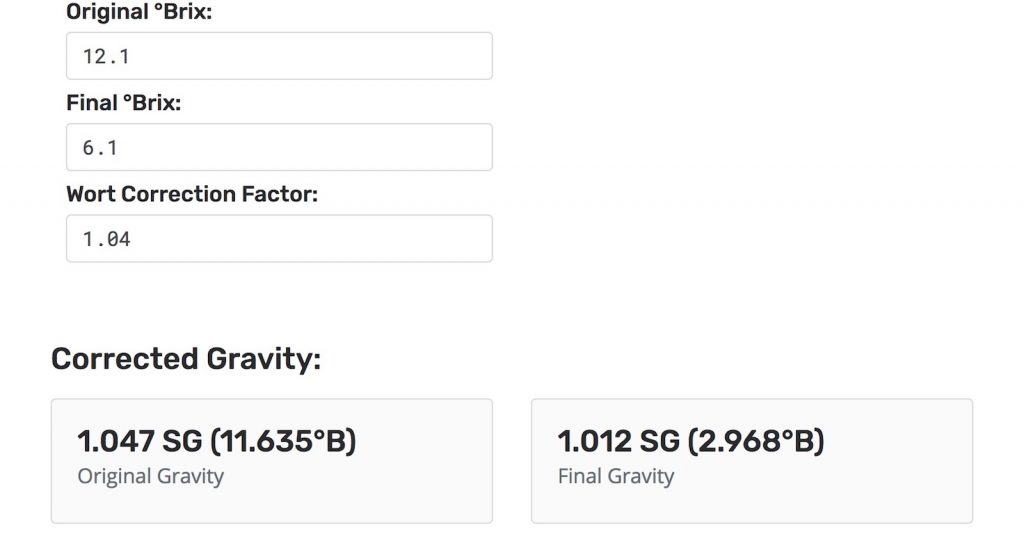
I don’t mind taking hydrometer samples to measure FG because it gives me an opportunity to taste the beer, but I absolutely love the idea of being able to steal a few drops as a way of checking fermentation progress.
| THE VERDICT |
Indeed, the Hanna digital refractometer costs more than commonly used handheld refractometers and hydrometers, and no, it’s not necessary for the production of good beer. I get it. Would I recommend everyone go out and buy one immediately? Of course not, but neither would I recommend people not buy one. That’s up to each brewer to decide for themselves. While the unit may be cost prohibitive for some, that doesn’t change the fact that it is solidly built, incredibly easy to use, and remarkably accurate. For those who care about this stuff and brew frequently enough, the Hanna digital refractometer may very well be a worthy purchase.
With as often as I brew, and especially given the experimental nature of my brewing, I’d been eyeing digital refractometers for a few months prior to receiving the Hanna for review. Most of what I found was comparable in price if not slightly more expensive, and the cheaper options didn’t offer the features I desired such as measuring in degrees Plato. The Hanna certainly fit my preferences closest, and while I think it’d be rad if it allowed users to switch between different measurement scales, I understand why this is difficult and don’t mind using a free online calculator for conversions. The only other downside I can think of is that it runs off of batteries that will eventually require replacement. For as little time as the unit is actually on when taking readings, I’ve a hunch the battery life is going to be quite high, but it’d be nice to avoid this all together by being able to plug it in.
Overall, my experience using the Hanna digital refractometer has been very positive and I’ve little doubt those interested in such a device would agree it’s a high quality machine that offers another level of convenience to the brew day. The Hanna Instruments HI96841 Digital Refractometer for Brewing is currently only available direct from Hanna’s website.
If you have any questions or thoughts about this product, please leave them in the comments section below.
Support Brülosophy In Style!
All designs are available in various colors and sizes on Amazon!
Follow Brülosophy on:
FACEBOOK | TWITTER | INSTAGRAM
If you enjoy this stuff and feel compelled to support Brulosophy.com, please check out the Support Us page for details on how you can very easily do so. Thanks!


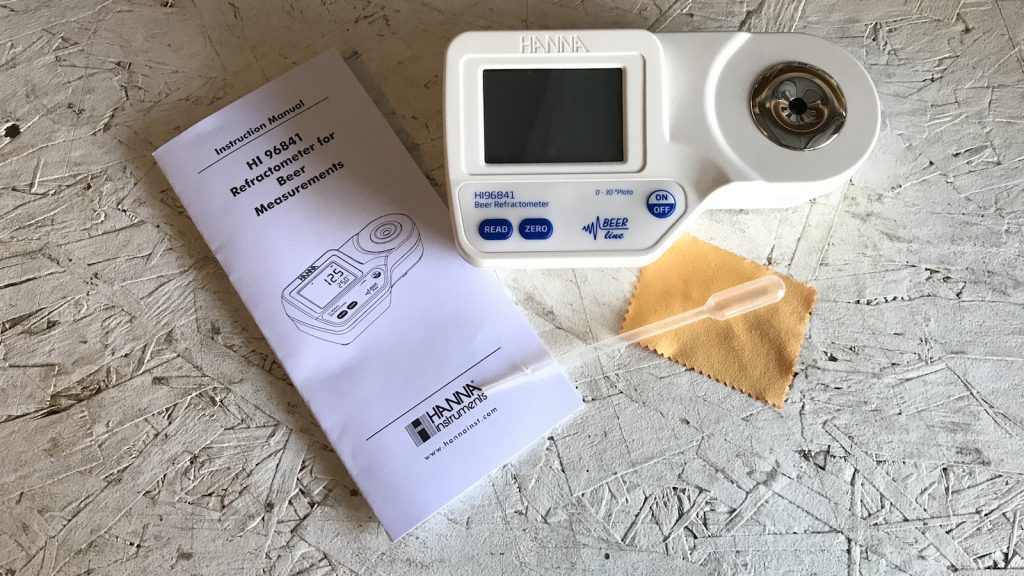
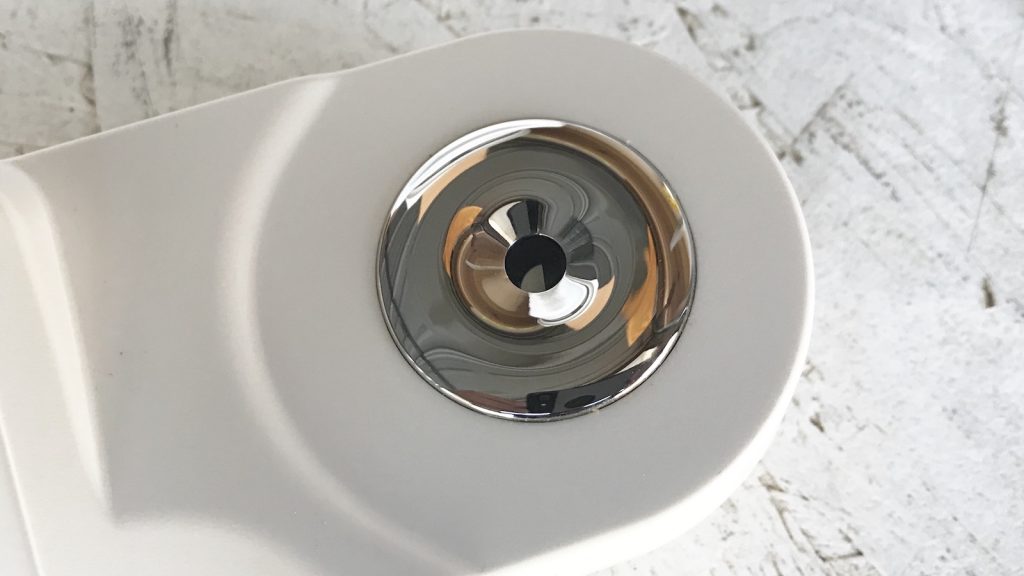

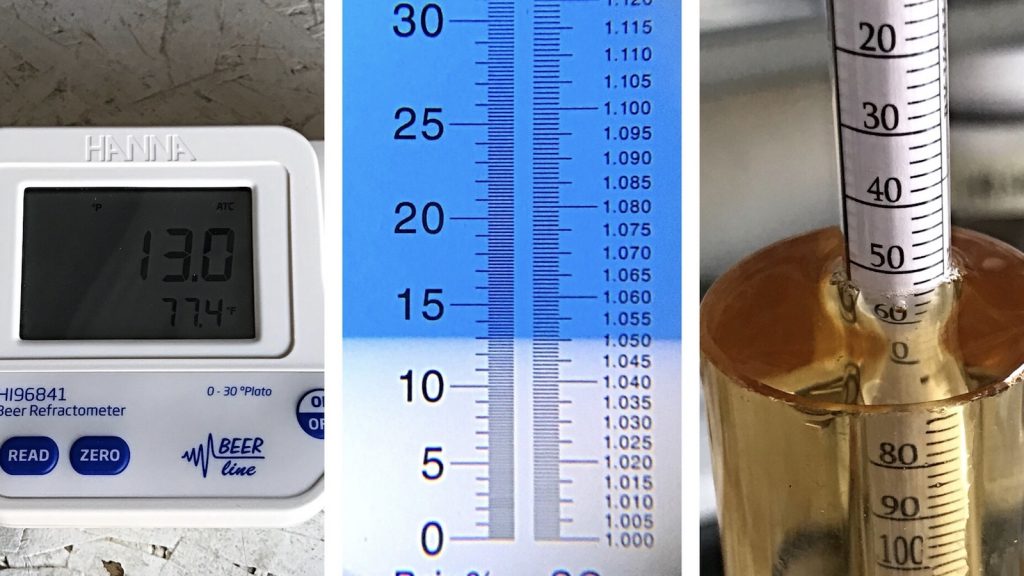
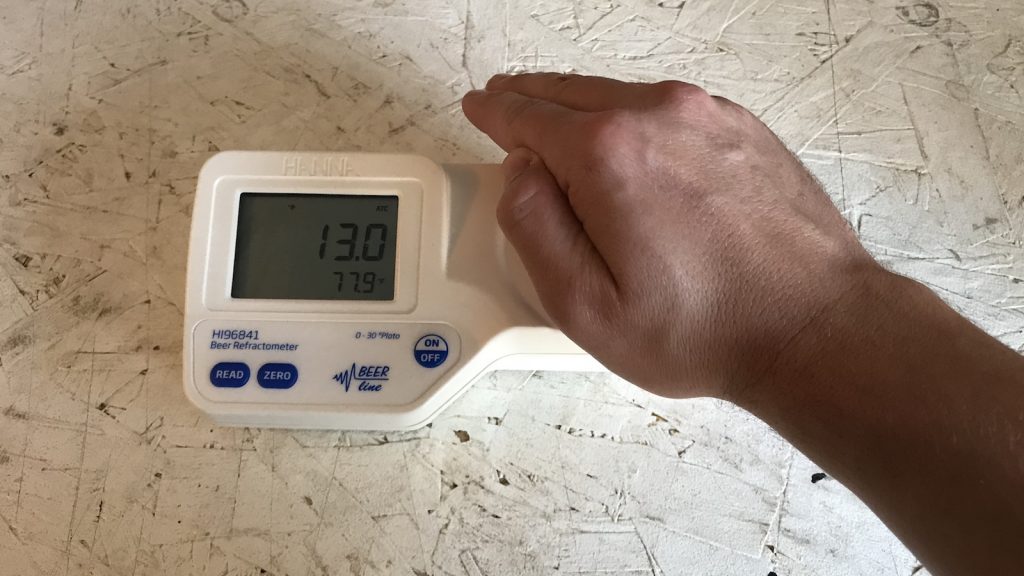
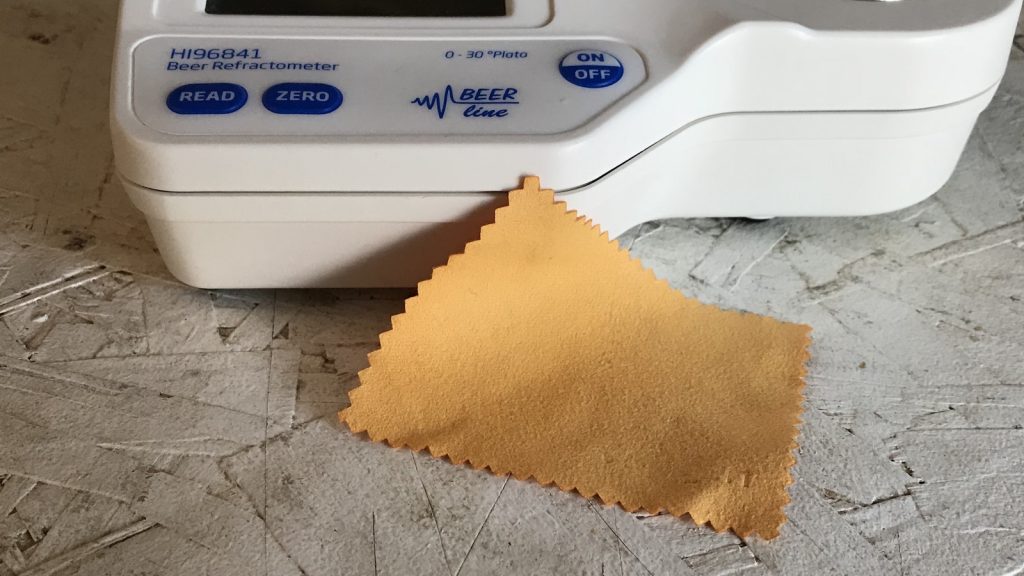
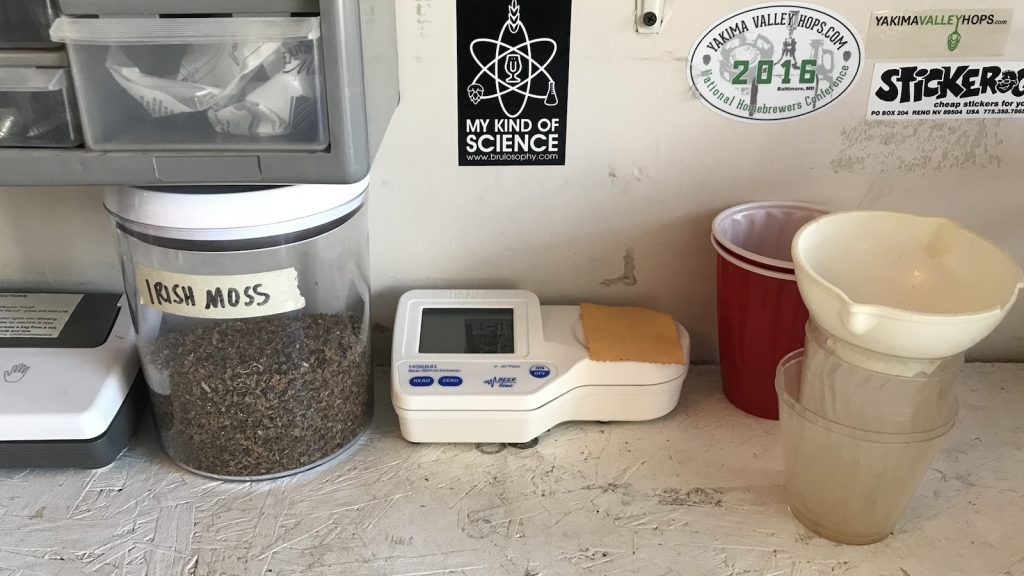
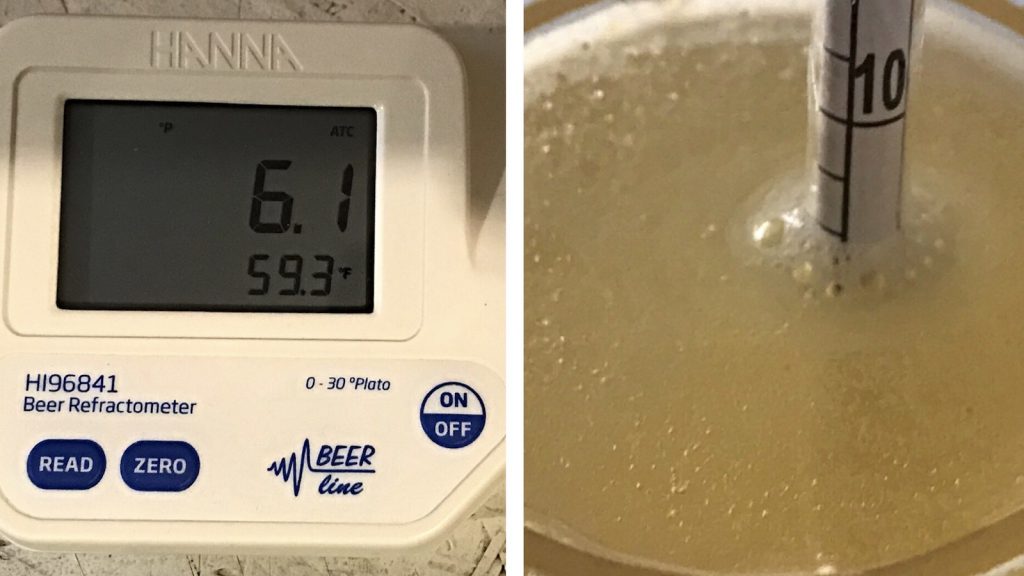
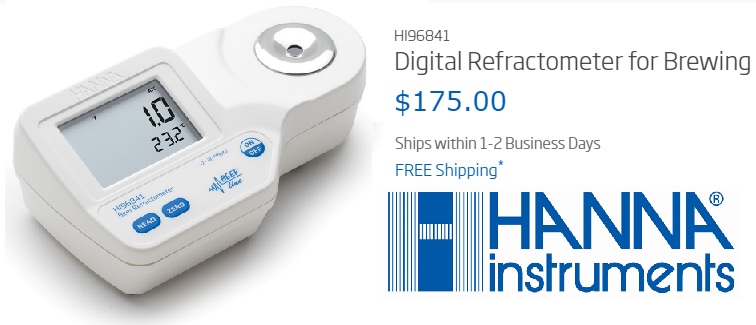










21 thoughts on “Product Review | Hanna Instruments Digital Refractometer for Brewing”
I bought one of these about 3 years ago. The main reason for me buying one was I had a hand held and my eyes are going bad and it was very tough to see where that line hit the numbers. As far as storage, I keep mine in the original box. I keep a pipette and a little SG to Brix reference chart that I printed so I wouldn’t need to look up any conversions on the fly. Also, batteries…. I can’t remember ever changing them. Maybe I did over the time I had it but batteries don’t seem to be much of a concern.
The batteries do last a really long time. I use one frequently in my work, and it isn’t just a reading or to here and there. The one comment I have is about the temperature compensation – that can be a bit of trouble. If a sample is too hot, evaporation will affect the reading as water can evaporate during cooling. Usually what we do is get the bulk sample close to the “standard” temperature, usually around 20 C.
That looks like a nice but unessential tool but when has being unessential stopped most brewers from wanting a cool, high tech piece of gear!
Reading about how you organize your brewery is something I’d like to know more about. I always feel that I can improve my setup. Would you mind sharing some information or pictures?
I really want one of these, have to sneak it past the accounting department 😉 When I started using my handheld, I would pre-calculate what my final backward-adjusted brix should be for final gravity so rather than having to calculated what my reading was, I already knew what it needed to be unadjusted to represent my target F.G.
If you’re just making beer for you and your friends, it’s a waste of $’s. Been making beer for 15 years, been told to enter competitions, no interest. All I use is a $7 thermometer, and a $12 hydrometer. My advise is always use a yeast starter, and always cold crash before carbonating.
And the most useless reply of the thread go to . . .
Thanks champ!
Milwaukee sells a similar unit (MA871) for quite a bit less which comes in a nice plastic storage case. Bought mine from Amazon.
I believe you’re referring to this one: http://amzn.to/2zS9dS9
When I first read this post I thought it was crazy expensive and entirely useless. But, after going to Hanna Instruments website and checking out some of the other cool stuff they have I’ve decided to give it some consideration (and maybe grab one of their PH meters). Since my current refractometer has been giving me such a headache and hydrometers take too long to cool a sample large enough to actually read, I’m in the market for a solution.
In my most recent brews, the SG pre-boil has been coming out much higher than my preferred brewing calculator predicts and the SG post-boil is much lower than expected…so I don’t know what to trust or what the root of the problem actually is.
In short, would you recommend buying this thing or should I spend the money on something else?
I try to avoid making overt recommendations as a rule since everybody’s situation is different. Rather, I will say that I really like the Hanna digital refractometer and think anyone looking for such an item would as well. That said, it’s certainly not a necessity, hence there might be other things you personally could use more than this.
The HANNA and the Milwaukee I suspect are really the same thing. Same shape, buttons and specs, so… I have a Milwaukee one because I got it on sale from Amazon (possibly a mis-listing since the price almost immediately doubled). After a year or so I had it keel over and got a replacement from Milwaukee very quick. Quite happy with it.
BTW this site
http://seanterrill.com/2010/07/20/toward-a-better-refractometer-correlation/
Is a much better conversion tool. You can go even farther if you follow the article a few months back in Zymurgy. With those tweaks it becomes very accurate. If you are on a Mac you can use this tool.
http://www.askincstudios.com/zz_misc_files/stuff//ASK%20Brewing%20Tools%201.3.3.zip
It has the Zymurgy changes built in
So do you still need to figure a wort correction factor and apply that for accurate measurements with this?
For FG, absolutely. I used an online calculator, super easy.
was it about 1.04?? I have found higher end optical refractometers, are closer to 1.00 and not needed…
I believe so.
I’ve been using the Hanna for a few years, not this one, a slightly older model. I use Sean Terril’s spreadsheet to calculate FG. I recently got a set of decent hydrometers and found the Hanna to be pretty much spot on. Not too long after I got the hydrometer set I broke the FG one FWIW, despite being super careful, then the glass sample tube… I’m not replacing either. The Hanna is just easier to use, I can check gravity at any point during the process without having to cool down the sample, and without having to take very much wort or beer at all. Love this site BTW, I’ve been perusing the articles and applying some changes in my process with positive results! Been brewing 12 years, but there’s still stuff to learn, thanks!
I actually have a Milwaukee model that I got on sale for about 1/2 off. but even at full price it’s a lot less.
https://www.amazon.com/Milwaukee-Instruments-MA885-Digital-Refractometer/dp/B00IAJE26G/ref=sr_1_18?s=industrial&ie=UTF8&qid=1526700595&sr=1-18&keywords=digital+refractometer
That is quite a bit cheaper. I have a feeling that both companies products are made by the same company. They are physically identical (when yo look at comparable models).
Any hoo I also highly recommend using Sean’s formulas or even better the slightly improved version that was in Zymurgy awhile back.
If you are on a Mac I have a little calculator that uses the latest tuned formula.
http://www.askincstudios.com/zz_misc_files/stuff//ASK%20Brewing%20Tools%201.3.3.zip
BTW My refractometer reads in BRIX but BRIX and Plato are a small fraction different. That 13Bx translates to 12.9994P so really meaningless.
I called them today and it sounds like this is exactly like their Brix refractometer except the Brix meter measures 0-85 and displays in Brix (vs. Plato). Any insight into why one might choose this over the Brix meter? They’re the exact some price.
I have a Milwaukee Brix version, though they look exactly the same so I bet both are made by the same place and then rebranded.
Anyway part of your problem with discrepancies is you are not using a very accurate conversion. Sean Terrill worked out a better conversion and in an article in Zymurgy Petr Novotny enhanced it.. I think he has it as a spreadsheet calculator? I took that formula and built a little calculator app that I use.
So for the cider
“the SG was 0.003 points shy of the calculated conversion to 1.053 SG”
First off the better formula gets you 1.050 for the refractometers and it looks like the SG is 1.049. But the sample is at 77.4 degrees according to the refractometer so that would put your corrected SG at 1.051. Either way they differ by only one point, and that could be a rounding issue.
For the beer OG 12.1 = 1.047 and FG 6.1 = 1.009, which again looks like a one point difference.
If people watch these devices show up on sale every once in awhile, I got mine at about 50% off on Amazon. Is it a pricey tool well yes sort of, but I wear glasses and with my prescription I need to be wearing them to read the analog refractometer and that makes seeing the scale a bit dodgy as I try to keep out extra back light. With fast readings that are easy to read it is worth it for me.
It is also worth pointing out that P and Bx conversions are most accurate in the middle. They are still pretty good in any range a homebrewer is likely to need but if your big beer is aiming at 20% the FG P/Bx numbers are going to be further off than they will be at a 4% – 10% FG.
BTW the little app Mac only is at http://www.askincstudios.com/zz_misc_files/stuff//ASK%20Brewing%20Tools%201.3.3.zip
I can in theory generate a windows version but I have no way of checking if it actually works or “fixing” it if it doesn’t. But if someone wants to give a shot at sticking the formulas into something I can give you source files.
Also the BRIX tools in Beersmith have apparently been updated and in V3 the results are very close to the tweaked version I’m using.
oops, sorry I kind of repeated myself!